How to install Ubuntu on Raspberry Pi
Raspberry Pi has always been the most popular single board computer. It can be used for various purposes, such as: desktop PC, home audio and video center, smart WI-FI router, automated operating system and game server. There are countless user scenarios.
If your Raspberry Pi does not come with an SD card pre-installed with NOOBS when it leaves the factory, you need to manually install an operating system on your SD card. You can run many different operating systems on Raspberry Pi, including: Windows 10 IoT, FreeBSD, and various Linux distributions, such as Arch Linux and Raspbian.
This guide describes how to install Ubuntu on a Raspberry Pi. Ubuntu is the most popular Linux distribution. It can run on a variety of hardware, from high-end computers to micro devices, such as Raspberry Pi.
Installing Ubuntu is very simple, just write an SD card. We will show you how to flash the Ubuntu image, start the Raspberry Pi, and connect to the Internet.
1. Flash image to SD card##
There are many different free applications that we can use to import ISO images into SD cards. In this guide, we will use Raspberry Pi Imager.
Raspberry Pi Imager is an open source tool used to flash the operating system running on the Raspberry Pi to the SD card. The operating system can be Windows, macOS, and Ubuntu.
Go to Raspberry Pi download page, download the latest version of Imager suitable for your operating system, and install this application.
Please note that flashing an image to the SD card is a destructive process, it will erase all data. If you have data on the SD card, back up it first.
- Insert the SD card into your SD card reader and start the Raspberry Pi Imager application:
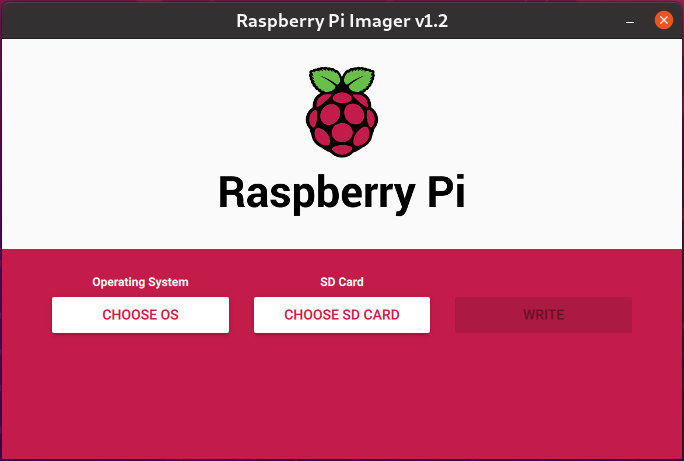
- Click the "CHOOSE OS" button, open the menu, select the operating system, scroll down, and select "Ubuntu":
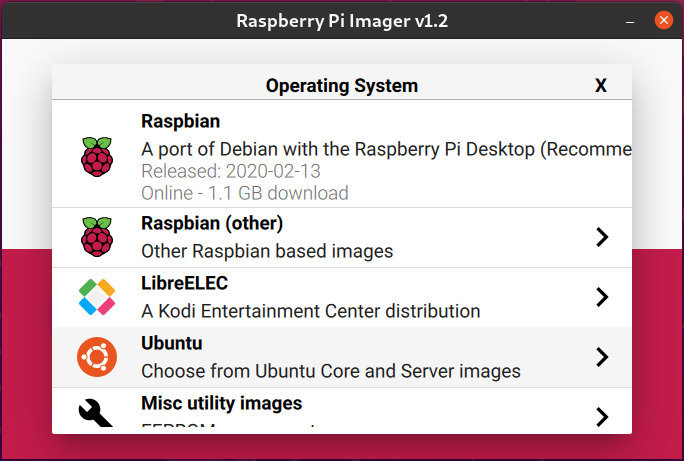
- You will be shown a series of Ubuntu images for selection. Choose according to your Pi version. In this guide, we use Raspberry Pi 4 (4 GB RAM) and choose Ubuntu 20.04 64-bit:
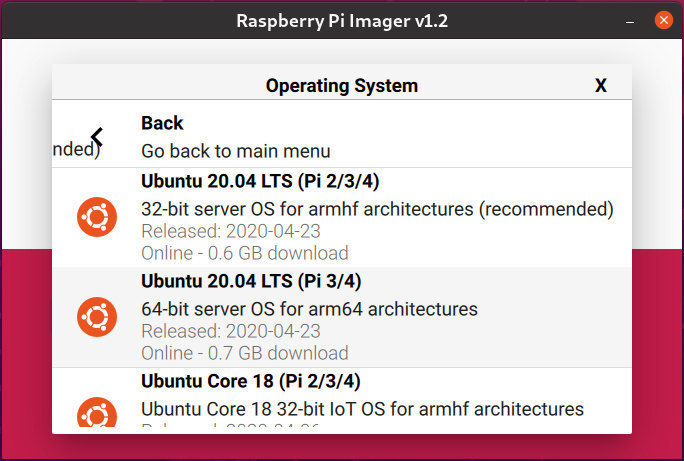
- Click the "CHOOSE SD CARD" button and select the SD card you inserted in the new menu. If you insert multiple SD cards into the system, please make sure you select the correct disk drive before flashing the image.
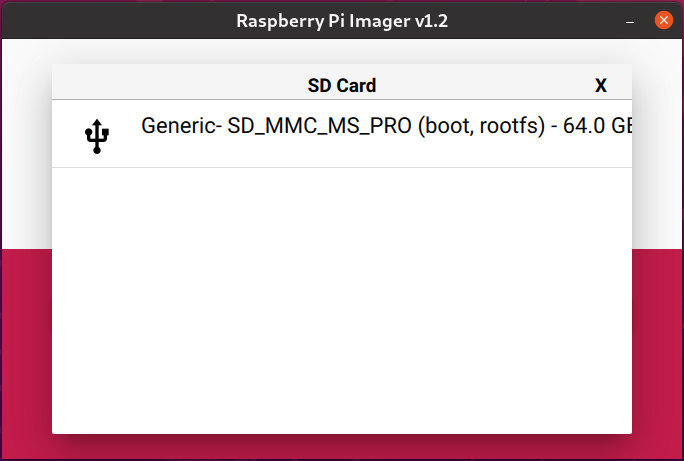
- Click the "WRITE" button, Raspberry Pi Imager will download the selected image and start the flashing process:
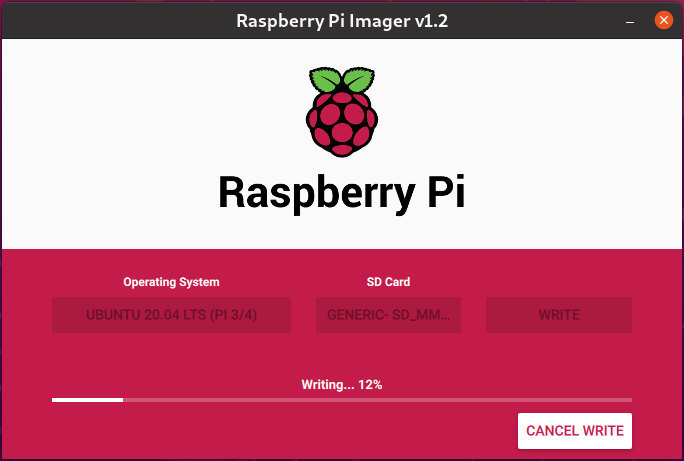
This process will take a few minutes, depending on your file size and SD card speed.
- After success, the application will display the following information:
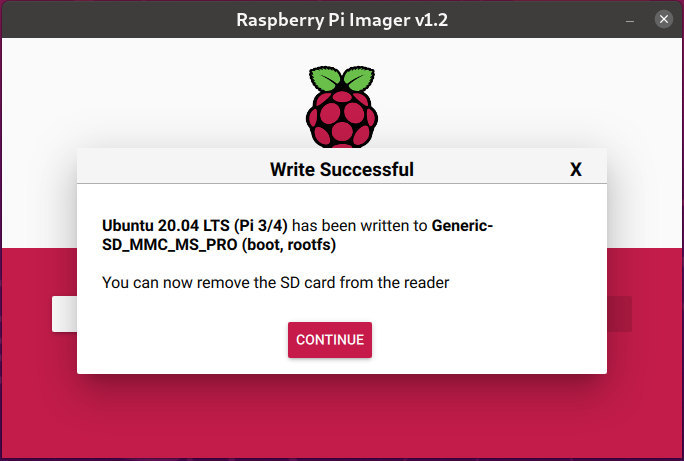
that's it! You have installed a bootable Ubuntu on your SD card.
Two, network settings##
You can connect your Pi to the network, using Ethernet or Wi-Fi. If you plan to use a wired connection, please use a network cable to connect Pi to your home router, and skip the next step in this section.
To connect your Pi to a wireless network at startup, you need to edit the network configuration file and enter your Wi-Fi information.
-
If you remove your SD card from your computer card reader, please reinsert the card reader. The SD card will be automatically mounted.
-
Use your file manager to browse to the
system-bootpartition on the SD card. -
Open the
network-configfile and update it with WiFi authentication information. For example, if your wifi network name is "my-router" and your wifi password is "S3kr1t", you should edit the file as follows:
version:2
ethernets:
eth0:
dhcp4:true
optional:true
wifis:
wlan0:
dhcp4:true
optional:true
access-points:
my-router:
password:"S3kr1t"
- Save the file and remove the SD card from your computer. When booting up, your Pi will automatically connect to the specified network.
Three, start Raspberry Pi
You can use Raspberry Pi as a headless machine and connect to the Pi via SSH, or connect to an HDMI display.
Insert your SD card into your Pi and turn on the power. If you are using a monitor and keyboard, please plug them in before you power on the Raspberry Pi motherboard.
The default username is ubuntu and the password is ubuntu.
Pi will take a few minutes to start up. Once it is up and online, you can see your Raspberry Pi IP address on your router's DHCP lease table, and log in to your Ubuntu via SSH:
ssh [email protected]
When you log in for the first time, you will be asked to change the ubuntu user password.
Four, summary##
Installing Ubuntu on the Raspberry Pi is a very straightforward process. All you need to do is to write the image to the SD card and start the Raspberry Pi.
Recommended Posts